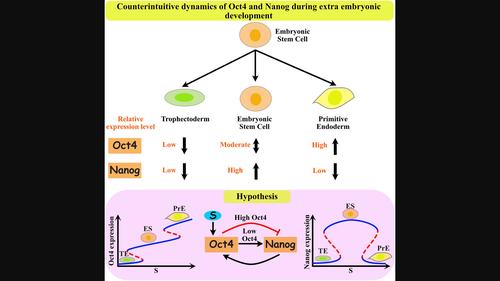当前位置:
X-MOL 学术
›
FEBS Lett.
›
论文详情
Our official English website, www.x-mol.net, welcomes your feedback! (Note: you will need to create a separate account there.)
Interlinked bi‐stable switches govern the cell fate commitment of embryonic stem cells
FEBS Letters ( IF 3.5 ) Pub Date : 2024-02-27 , DOI: 10.1002/1873-3468.14832 Amitava Giri 1 , Sandip Kar 1
FEBS Letters ( IF 3.5 ) Pub Date : 2024-02-27 , DOI: 10.1002/1873-3468.14832 Amitava Giri 1 , Sandip Kar 1
Affiliation

|
The development of embryonic stem (ES) cells to extraembryonic trophectoderm and primitive endoderm lineages manifests distinct steady‐state expression patterns of two key transcription factors—Oct4 and Nanog. How dynamically such kind of steady‐state expressions are maintained remains elusive. Herein, we demonstrate that steady‐state dynamics involving two bistable switches which are interlinked via a stepwise (Oct4) and a mushroom‐like (Nanog) manner orchestrate the fate specification of ES cells. Our hypothesis qualitatively reconciles various experimental observations and elucidates how different feedback and feedforward motifs orchestrate the extraembryonic development and stemness maintenance of ES cells. Importantly, the model predicts strategies to optimize the dynamics of self‐renewal and differentiation of embryonic stem cells that may have therapeutic relevance in the future.
中文翻译:

相互关联的双稳态开关控制胚胎干细胞的细胞命运
胚胎干(ES)细胞向胚胎外滋养外胚层和原始内胚层谱系的发育表现出两种关键转录因子Oct4和Nanog的独特稳态表达模式。如何动态地维持这种稳态表达式仍然难以捉摸。在此,我们证明了涉及两个双稳态开关的稳态动力学,这两个双稳态开关通过逐步(Oct4)和蘑菇状(Nanog)方式相互连接,协调了 ES 细胞的命运规范。我们的假设定性地协调了各种实验观察结果,并阐明了不同的反馈和前馈基序如何协调 ES 细胞的胚胎外发育和干性维持。重要的是,该模型预测了优化胚胎干细胞自我更新和分化动态的策略,这可能在未来具有治疗相关性。
更新日期:2024-02-27
中文翻译:

相互关联的双稳态开关控制胚胎干细胞的细胞命运
胚胎干(ES)细胞向胚胎外滋养外胚层和原始内胚层谱系的发育表现出两种关键转录因子Oct4和Nanog的独特稳态表达模式。如何动态地维持这种稳态表达式仍然难以捉摸。在此,我们证明了涉及两个双稳态开关的稳态动力学,这两个双稳态开关通过逐步(Oct4)和蘑菇状(Nanog)方式相互连接,协调了 ES 细胞的命运规范。我们的假设定性地协调了各种实验观察结果,并阐明了不同的反馈和前馈基序如何协调 ES 细胞的胚胎外发育和干性维持。重要的是,该模型预测了优化胚胎干细胞自我更新和分化动态的策略,这可能在未来具有治疗相关性。



























 京公网安备 11010802027423号
京公网安备 11010802027423号